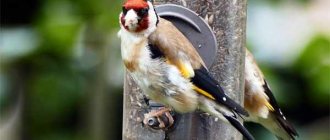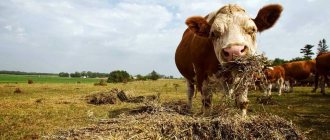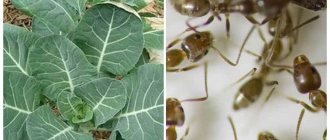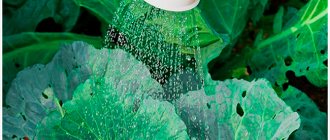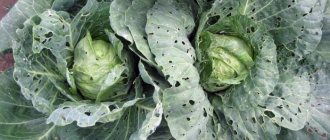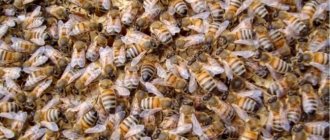About hacienda » Vegetable growing » Cabbage
Cabbage
Winter crops occupy an important place in the lives of summer residents. Our grandmothers also began preparing dishes from fresh vegetables much earlier than us. This is because planting began not in spring, but in late autumn. Many people still use this method today. But along with other crops, cabbage is undeservedly forgotten. This healthy, vitamin-packed vegetable can successfully survive the winter cold and sprout in early spring.
Planting cabbage before winter 757 Just 30-40 years ago, the climate in our region was a little different. The summer was hot and rainy, and the winter was frosty and snowy. The crops did not have to adapt and experience thaws several times a season. In addition, gardening was mainly carried out by village residents. There were no dachas, in the modern sense. And it’s easier to grow any crop on a personal plot. At the right time, leave the house and plant. The seeds were always there. And this guaranteed the quality of the future product and germination.
Modern gardeners are trying to keep up with their ancestors. Those who are especially diligent begin to boast about the harvest at a time when others are still weeding the weak seedlings. Winter planting makes it possible to grow white cabbage a month earlier than usual. And this is a noticeable difference. In this way, an early harvest is also obtained from cauliflower and Pikin cabbage.
In the spring, all summer residents have a huge problem with the lack of space for boxes with seedlings. Young shoots require a lot of sunlight and heat. This can only be ensured by placing the boxes on the windowsills. The latter are sorely lacking. It is not always possible to transport your wealth to the dacha. In cold rooms during frosts it can freeze and die. Planting individual crops for the winter will also help to avoid these problems.
Related article:
Features of growing vegetable crops (cabbage, peppers, cucumbers)
What are the advantages
What are the advantages of winter planting that you might not have guessed about:
- When sowing in open ground, you will see the first shoots two to three weeks earlier. If you cover the bed with film, everything will happen faster. This way you will harvest the harvest a month earlier than your neighbors.
- Gardeners who plant plants in the spring are faced with the problem of drought. In our case this will not happen. Since the seeds take moisture from melted snow. This makes them strong and hardened.
- There is no need to waste time and space growing seedlings in the spring. There will be fewer boxes on your windowsill.
- In spring, when planting is in full swing, you have more time to plant and care for other plants.
- Cabbage planted for the winter awakens and sprouts very early. At this time, various pests and pathogens are still sleeping. By the time they begin to actively attack the seedlings, the cabbage will have already become stronger and will be able to effectively withstand attacks.
- The seeds harden in winter and strengthen the immune system. The strongest and healthiest survive until spring.
- The harvest from winter planting is distinguished by its juiciness and taste.
Spring work and feeding cabbage
The seeds begin to sprout when the snow melts and the soil warms up slightly. However, the weather is usually unstable and there is a risk of frost. To protect the seedlings, you need to use arcs on which covering material is pulled. Cut-off plastic bottles also work great.
The soil under the seedlings must be covered with a mulch layer. To do this, you should use pine needles and sawdust. Grass or hay will also work. If necessary, it is recommended to thin out the sprouts. When the weather stabilizes, the cabbage will begin to grow quickly. This will help you get a harvest in the shortest possible time.
As sprouts appear, it is worth applying fertilizer. It is recommended to alternate organic products and mineral preparations.
Important! It is recommended to water the cabbage evenly. The frequency of soil moisture is 4-10 days.
Disadvantages of the method
Such prospects can turn the head of a novice gardener. But do not forget about the existence of pitfalls:
- Additional work in the fall. Formation and arrangement of beds. Planting seeds. All this takes time.
- It will require twice as much seeds for planting. Therefore, material costs will increase.
- You need to monitor the weather and be patient and have a thermometer. Planting requires a certain temperature. Be ready to go to the site any day.
- When the shoots emerge in the spring, they must be protected from cold and bad weather. You will have to make a greenhouse or cover it with film.
- The weather in winter is unpredictable. Unexpected changes in temperature. Thaws and frosts can destroy the seeds and all your work will be lost.
Related article:
Growing Broccoli: 8 Helpful Tips
What varieties of cabbage to plant before winter
It is extremely important to choose the right varieties that will withstand unstable conditions at this time in early spring: alternating cold spells, thaws and possible recurrent frosts. There is an opinion that early ripening varieties are more resistant to low temperatures than late ripening ones. However, mid- and late-ripening varieties are usually grown at these times. Only frost- and cold-resistant varieties will not leave you without juicy hard forks.
Varietal types of white cabbage recommended for winter sowing: Vyuga, Nadezhda, Sibiryachka, Polyarny K-206, Dumas, Gribovsky.
Redhead : Stonehead 447, Early Hardstone, Early Red.
Colored : Guarantee, Movir 74. Thus, almost all types of the cabbage family are suitable for autumn sowing.
Seeds must have high sowing qualities. However, do not forget to sow much thicker, with a reserve in case of possible loss of some of the seeds. I recommend not limiting yourself to one variety, especially one that is new to you. It is unknown what surprises he may present. It is better to use several, in case of possible failure with one variety.
Photo pixabay/CarlosLopez: Cauliflower can also be planted before winter.
Seed selection
There are a huge number of cabbage varieties known. They all differ in appearance and taste. The most popular varieties:
- Red-pumped.
- White pumped.
- Beijing.
- Savoy.
- Colored.
- Broccoli.
- Kale.
- Pak-choi.
Choose the type that suits you or plant several at once. Please note that early ripening cabbage can only be planted in spring. It is very tender and will not withstand winter frosts. Late and mid-ripening varieties are suitable for sowing for the winter.
More seeds are required. Increase the rate by at least 30%, or better yet, double it. A significant part of them will freeze and die. And if you regret the seeds in the fall, then in the spring you will find a lot of free space in the beds.
When to start
The most common mistake is failure to meet deadlines. It is for this reason that the seeds die in winter, and the harvest leaves much to be desired. Gardeners recognize the method as not working and stop using it.
The most common mistake is failure to meet deadlines.
Cabbage planted in the fall should begin to grow only in the spring. If you sow too early, the seeds will begin to hatch and die at the first frost. Wait for stable frosts. The soil should freeze and no longer thaw. There may be snow on the beds, but not much. Study weather forecasts carefully. This will help you choose the right time.
Related article:
Growing Broccoli
Selecting the sowing date
This issue often conceals the main mistake in winter sowing cabbage and subsequent failures in obtaining a harvest.
Most of our country is experiencing unstable weather. Cold spells alternate with thaws. All this is extremely dangerous for seeds sown at the wrong time. There is a high probability that the swollen seeds will not go into hibernation for the winter, but will begin to grow. Subsequent frosts will cause the death of young seedlings. In order not to make a mistake and not lose the main part of the seedlings in the future, you should regularly monitor the weather forecast.
| Advice. To plant cabbage before winter, you should choose a period when slightly frosty weather is stable. The optimal temperature during the day is from 0 to +3°C. Under such conditions, the soil freezes sufficiently, preventing the seeds from hatching. It is advisable to complete sowing before the time when snow covers the ground in a thick layer. |
Based on many years of observations, approximate dates for winter sowing of cabbage have been established:
- end of November – for the southern regions;
- end of October – for the north of the country;
- the second half of October-November - for the central part.
| Important. Always be guided by the situation developing in a particular territory in the current year. Pay close attention to weather forecasts. |
Site preparation
It is necessary to tidy up the soil before the onset of cold weather. It should be soft and loose. Form the beds. Choose a location so that it is blocked by a building on the north side. If this is not possible, make sides. In spring, the garden bed should receive sunlight. Melt water should not flood the sowing area. Follow the rules of crop rotation. An incorrectly chosen predecessor will ruin the whole thing for you.
It is necessary to tidy up the soil before the onset of cold weather.
Take care of the earth as you are used to doing it. Apply fertilizer if required. Potassium-phosphorus preparations, deoxidizers, and organics are suitable. Lovers of natural farming will replace all this with green manure, wood ash or humus.
How to prepare the soil
Soil preparation should begin a month before planting seeds in the ground. The beds need to be well loosened and the soil fertilized with vitamins and mineral complexes with potassium and phosphorus. Fertilizers should contain minimum amounts of nitrogen.
The enrichment of vitamins and minerals largely depends on the soil. So, in heavy and clayey soil it is necessary to add ash, sand, compost or leaf humus. In addition, it is important to provide the cabbage with slightly acidic soil, a sunny place and protect it from winds. Then the plant will survive the winter well and will delight you with an early harvest.
Advice from experienced gardeners
Having prepared the soil as described above, begin cutting furrows. Cover the bed with film or boards. Otherwise, rains may wash it away. When the cold weather sets in, you will open the bed and sow cabbage in the designated areas.
Making grooves and filling them with frozen soil is difficult. Make this work easier for yourself. Collect loose soil in boxes or buckets in advance. Stock up on humus and leaves. Keep supplies in a warm place. Use a shed or covered greenhouse for this purpose. Keep them there until the weather is suitable.
Experienced gardeners know how to make their work easier. At the right time, they scatter the planting material evenly over the bed. Using a rake, embed it into the soil. For this purpose, also use stored soil and foliage.
Our method involves planting dry material. There is no need to pre-soak or process it. Such actions stimulate growth, and in this case we do not need it. Seeds must be of high quality, large, and of the same size.
The nuances of caring for a garden bed in spring
The preservation of cabbage underground depends entirely on its wintering. If there were persistent frosts and there was snow, then there was a high probability that there would be a harvest. With the arrival of spring, cover is removed from the beds and cleared of snow. As soon as warm weather stabilizes, cabbage sprouts will appear on the surface of the ground. They will be strong and healthy, so if cold weather comes, they will easily survive it. As the seedlings grow, they will need to be thinned out or transplanted.
However, this is not all and it is too early to relax. In spring the weather is very unstable and young shoots can become victims. Despite the strength of young cabbage, it is better to build a shelter for it and protect it from sudden frosts. This can be a regular canopy made of metal arcs and plastic film. If there are few seedlings, then each can be covered with a plastic bottle. To do this, you need to cut off the bottom and cover the seedling, drowning the bottle a little in the ground.
Additionally, you can insulate the cabbage with an armful of early weeds, sawdust, and straw. Mulch is distributed under the seedlings on the ground.
When the spring weather returns to normal and the final warming comes, the cabbage will actively begin to grow and literally in two months, the neighbors will be jealous of the rich harvest of young cabbage heads.
Caring for winter-sprouted cabbage is no different from usually planted vegetables. Organic and mineral fertilizers are added to the soil: humus, potassium, nitrogen, phosphorus, etc. Sprinkling ash on the cabbage will help prevent caterpillar attacks. The seedlings are provided with abundant watering. Once every 10 days, pour out 25 liters of water. If you water more often, for example, every 4 days, the volume can be reduced to 10 liters. The crop is fed twice with dry fertilizers or their solutions. The first procedure is performed during the first waterings, the second - a week before harvest.
Rich harvest of cabbage
If you still have doubts about your abilities and knowledge, then you can combine winter sowing and planting seedlings. If the first option does not produce results, then the second will definitely ensure a future harvest. Although you shouldn't stop after one bad experience. You need to analyze your mistakes and, if possible, correct them, then most likely the second attempt will bring success.

